by Briscoe White | Feb 11, 2011 | Containers, Gardening, Growing, Herbs, Indoor Gardening, Life on the Farm, Miscellaneous, Urban Gardening |
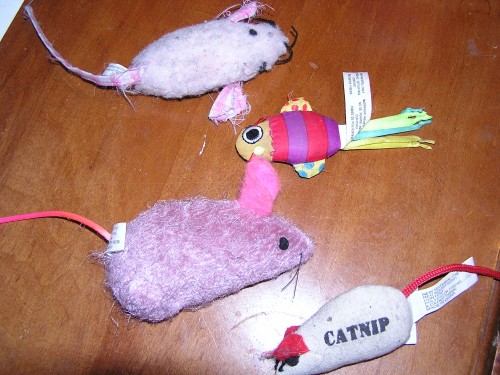
Tons of cat toys are packed with Catnip to perk your cat's interest!
Looking for a great all natural way to treat your favorite feline? Try Catnip! Often found packed into the plush insides of a cute little toy or sold in dried form at local pet stores, catnip makes most cats pretty crazy. Over eighty percent of cats are affected by the chemical component Nepetalactone, which is found in the essential oils of this perennial herb. A combination of genetics and age determine whether your felines will fiend for Catnip, as studies show that kittens don’t seem to respond until around the age of three months. Though not explored extensively, there are many cases of dogs and even some bears who find the scent of “nip” irresistible. Reactions range from sleeping and drooling, to frantically pouncing and running around, and cats seem to also experience heightened tactile sensations which may include being rubbed on their face, petted or brushed to excess.
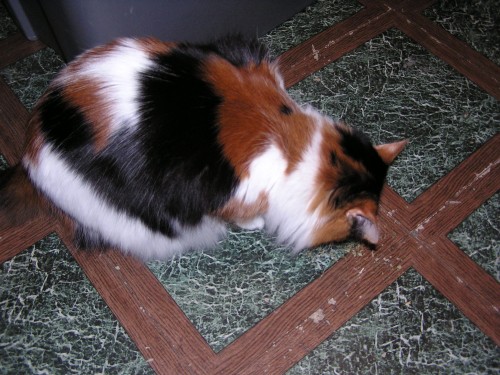
Our Media Director's cat, Sophie, eating dried Catnip. She likes the fresh stuff better!
Also known as an excellent natural insect repellent, the essential oils are often found in many DEET-free bug sprays. If making your own concoction to deter pests, try using Lemon Catnip for a fragrant citrus aroma. Catnip also has a history as a medicinal herb for its sedative properties and makes a soothing tea to help you relax, much like Valerian, an herb known to mellow you out and known commonly as “the poor man’s Valium”. Slightly numbing, Catnip is also reputed to strengthen immunities to fend off colds, fevers and the flu, and also calms an upset stomach. Growing fresh Catnip for your kitties isn’t just fun and games. The vitamins and nutrients they get from eating the raw plant is great for their bodies, and the plant itself can help cause any indigestion which may result from some store-bought foods.
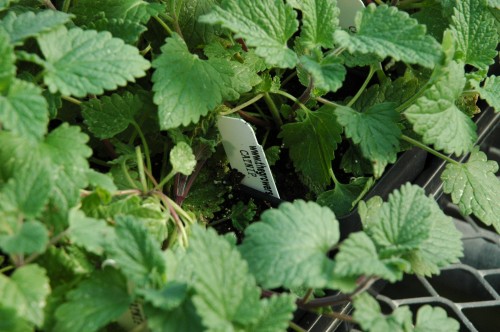
Our Catnip is all natural and because we don't use harsh chemicals, it's purrrrrfectly healthy for your cat!
If you plan to grow Catnip for your cats indoors, you may want to plant two pots, one to keep out of their reach outdoors, and one for them to enjoy inside, but make sure to swap them occasionally so they don’t completely attack the indoor pot! If you’re growing it outdoors, be aware that neighborhood cats may be flocking to your garden. To prevent their frantic frolicking from interfering with other, more tender plants that may be growing nearby, either plant your catnip in a well-drained, separate area of its own, or build a fence around your garden. (If you have problems with container-planted Catnip, try placing it in a large, metal bird cage or dog kennel, where the kitties can’t plow through it all and destroy your plant.) If you want to really encourage your cats to love you more, try planting Catmint, Lemon Catnip and Valerian in your garden. All three of these great herbs are kitty-friendly, human-friendly and make a really calming tea. Treat your cats the natural way and grow them a garden full of treats!
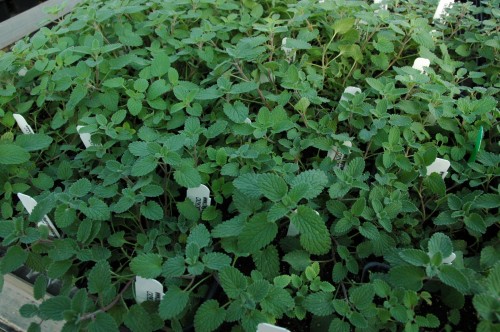
Catmint is another great herb to get your felines frisky!
by Briscoe White | Feb 10, 2011 | Inspiration, Miscellaneous |
Recently I was reading our two county bi-monthly newspapers. I try to read often to keep up with local news. Most issues carry reports of various crimes and court actions happening in the surrounding area, which is entertaining lunch reading. Until recently I had not even been aware of letters to the editor, but a half page one caught my eye and I read a dialog of what someone else thought wrong and right should look like. I never talk politics and never feel a need to express my version of Utopia to others. It is not that I am without opinion; rather I keep things in perspective because most contemplation goes on while doing gardening chores. Proper immersion into gardening mellows current events by contrasting with the slow and steady progress of the seasonal progression.
My first reaction after reading the zealous letter, was humor at the conclusion. This heart felt recipe for making everything right (with advice for fixing the wrong) ended with this call to arms: “What Say You?”. It was this call to arms that really stuck with me. To further strengthen this call, my mind wandered to someone I know who has been watching The Lord of the Rings! I guess the warrior spirit has come to life?
The real reason for the title is our desire here at The Growers- Exchange.com to hear from our many customers. In our continuing effort to improve our shipping, we would love to hear how all of those herb plants are growing out there all over the country. We base a good chunk of our business decisions directly from customer response and communication. We honestly do hear you and care about what plants or products you want, what measures we can take to be more efficient for you, and everything else, right down to your best garden advice.
Sitting around brainstorming how best to prepare our customer service reps, we thought it would be helpful to hear what are our customers’ most frequent questions are. So, even though we do have a sense of humor most of the time, right now, The Growers Exchange asks all of you, our customers: What Say You?
by Briscoe White | Feb 7, 2011 | Basics, Gardening, Growing, Herbs, Pests and Problems |
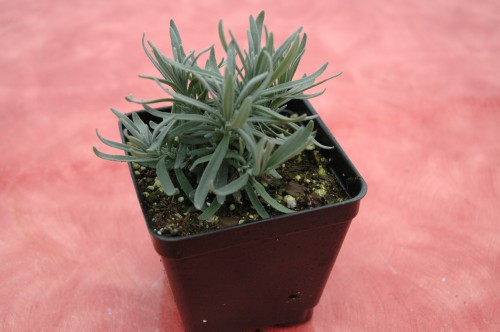
Healthy Lavender
Keeping potted lavender inside for winter can be tricky. They are so touchy about wet feet, they can turn from beautiful to pitiful in a few days. Overcast days with little sun are the perfect breeding ground for all the fungus that prey on lavender plants. Like potting succulents, sand should be added to the potting soil to insure quick drainage.
One sign of trouble is algae growing on the soil surface. This is an indication the soil is too wet for too long. When weather conditions are favorable, fungus will quickly colonize a water logged lavender. To save plants already infected, trim all dead leaves and stems. Clean all debris from the soil surface. Dry the soil quickly, even if you must remove the plant from the pot.
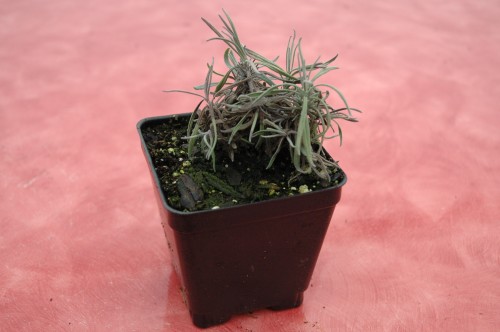
Fungally infected Lavender
There are many fungicides available, some are biological, others chemical. This natural fungicide is safe for kids and pets so if you’re conscious about little fingers or paws playing in the garden, a natural fungicide is often a better choice than a chemical one. In our greenhouse, we treat lavender every week by first spraying a Hydrogen Peroxide disinfectant, then a biological fungicide. Applying chemical fungicides takes less time because it has a residual effect for a week or more, but because we grow mostly herb plants that will be cut and used for culinary purposes, they must be clean and healthy to eat. Though the biological type does not last as long and must be applied more regularly, it’s worth the extra time and effort to ensure that our plants are healthy and treated in an all-natural way.
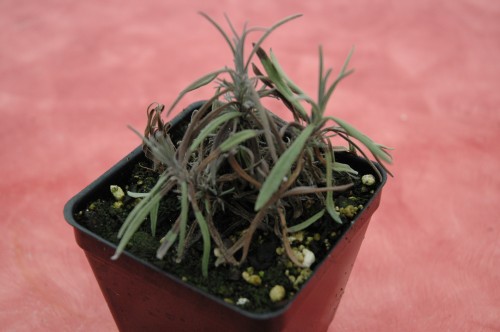
Lavender killed by fungal infection
We prefer to use PlantShield HC Biological Fungicide, which uses an active natural microbe to prevent disease from growing on the root structures and foliage of our plants. We drench the actual soil, rather than the leaves themselves, which allows this natural microbe to saturate the soil and protect the plants from mildew, fungi and other root pathogens. This is just one key step in our promise to ensure healthy, all natural herbs and flowers for our customers. Because of all of the careful nurturing that we employ at The Growers Exchange, we know our plants like the backs of our hands. Staying constantly familiar with our plants allows us to keep a close eye on quality control, and our attention to detail is something we pride ourselves on. Because of this process, we don’t let anything leave our greenhouse that we wouldn’t want to plant in our own garden, so you can be sure that when you order from us, you’re getting only the very best!
by Briscoe White | Feb 3, 2011 | Basics, Containers, Gardening, Growing, Herbs, Indoor Gardening, Seeds, Urban Gardening |
Nasturtiums are typically started from seed– but why do the sowing yourself, when we are happy to sow them for you? While most of the country is experiencing another record-setting snowy winter, your nasturtiums are in good hands here on the farm, safe in our warm and well-tended greenhouse. While most people are ordering seeds that ship immediately, we’re nurturing and hand tending our plants with care until it is warm enough to ship them via mail couriers like Fedex, this spring. This way, you get healthy, happy plants that arrive on your doorstep and are ready to plant or pot, instead of seeds that have battled the rigors of the icy weather AND the postal system. Our nasturtiums are a great example. Below, see us starting these little guys on their life journey.
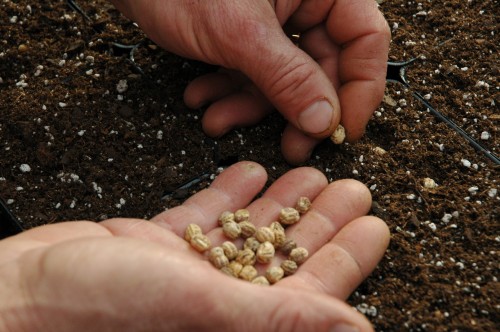
Sowing Nasturtium seeds
When spring arrives at last and you receive your Nasturtiums, plant them in well-drained soil and full sun. They are easy to grow, and do not require a lot of maintenance. In fact, they do better with a little neglect. They like weekly waterings, or whenever soil is dry to the touch.
Nasturtium leaves have an interesting watercress flavor to them, and are a wonderful addition to salads and cheese sandwiches. Use them to spice up cream cheeses, dips, or egg dishes. Colorful nasturtium flowers are not only beautiful, but are also edible. Many health food stores carry these edible flowers– but at a high price! Take advantage of your nasturtiums by picking their flowers soon after they open up. The flowers can be served whole as a gorgeous decoration to cakes, or petals can be sprinkled on salads.
If you would rather keep your blooms on your plant, be sure to remember to pick off dead blooms. This will allow your nasturtium to bloom continuously. If you don’t dead-head them, they will start to go to seed, as our social director Caroline recently discovered! You can read about her experience in our previous blog. These seeds can also be pickled and used as you would use capers.
by Briscoe White | Feb 2, 2011 | Exploring, Miscellaneous, Wildlife |
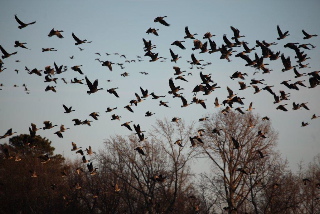
Photo Courtesy of Brad Fenson
Working in the greenhouse today, we were lured from our mundane task by the uproar of several hundred, maybe a thousand Canadian Geese in the adjacent field. After a few moments of loud and excited goose talk, we all ran outside to see them fly over. Whatever it was that scared them was not so bad because most settled back where they began. Some landed in the field beyond our orchard, giving us a clear view of flock after flock gliding in on set wings.
We went back to work when most of the birds had settled back in the fields, foraging ravenously before the next cold weather arrives. And we went back to inventory. But even counting everything is not so bad when you can take a break with the neighbors every now and then.









